Japan Wood Products
Prices
Dollar Exchange Rates of
10th
August 2015
Japan Yen 124.4
Reports From Japan
Negative long-term prospects brings down consumer
confidence index
The consumer confidence index released by Japan‟s
Cabinet Office shows there was a weakening of sentiment
in July, the index fell to 40.3 from the 41.7 in June, the
lowest in six months.
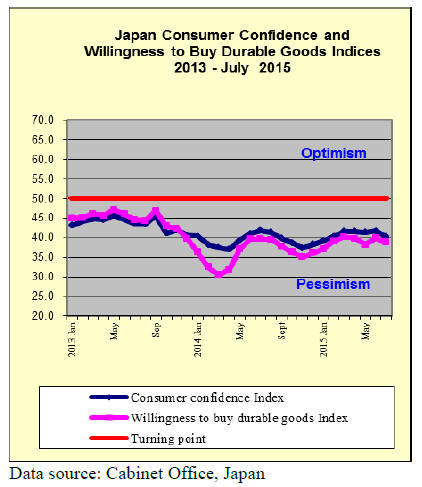
All associated indicators contributed to the negative trend
in sentiment in the July indices. The overall livelihood
index fell to 38.1, the income growth index fell to 39.6
from 40.3, the employment prospect index dropped
sharply and the willingness to buy durable goods index
also fell.
The main reasons cited for the poor second quarter data
are slow income growth, rising prices and negative long
term perceptions for economic recovery.
For more see:
http://www.esri.cao.go.jp/en/stat/shouhi/shouhi-e.html
GDP forecast lowered
The Bank of Japan (BoJ) has lowered its forecast for GDP
to a 1.7% year on year growth in the year to March 2016,
down from 2% forecast at the beginning of the year as the
latest figures show GDP growth was negative in the
second quarter of the year. As a result of the slowing of
the economy many in Japan are calling on the BoJ to come
with further stimulus measures. But the BoJ signaled it has
confidence the economy will turn-around which is defying
all current indicators.
Yuan devaluation yet to impact yen exchange
rate
In early August the yen weakened after the US Federal
Reserve reaffirmed that the risks to the US economy from
an interest rate rise were receding. However, with the
latest round of yuan devaluations, the Federal Reserve
may decide to delay a rate hike.
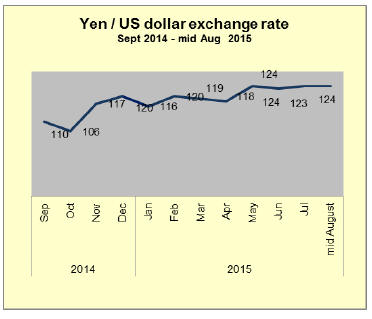
First half housing starts
Despite the swings in month housing start data for the first
quarter of 2015, overall starts for the six months to June
2105 are only marginally down on levels in the same
period in 2014. Reassuringly, the trend in starts in the first
half of each of the two years is following a similar pattern.
Japanese house buyers, especially those with young
families, are beginning to look at second hand as they can
get a good house at a reasonable cost.
Second hand homes are attracting those currently in rented
apartments as monthly repayments on housing loans are
turning out to be lower than the apartment rent in this time
of low interest rates. But sales of homes, especially second
hand homes are slow with around 10 homes available for
every buyer.
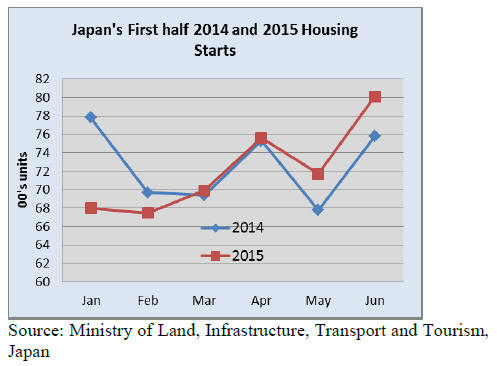
Import round up
Doors
June 2015 imports of wooden doors by Japan were slightly
up on levels in May however figures for the first half of
2014 and 2015 show that Japan‟s wooden door imports
fell around 18% in the first half of 2015.
China and the Philippines top the list of suppliers in June
(59% and 16% respectively) but imports from Malaysia
lifted the SE Asian nation into third place as a supplier of
doors to Japan.
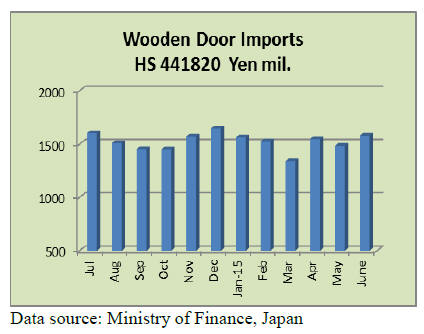
Windows
Japan‟s June 2015 imports of wooden windows were
unchanged from a month earlier but, compared to the first
half of 2014, 2015 imports were down a massive 28%.
Imports from China accounted for 32% of imports as did
imports from the Philippines. The third ranked supplier in
June 2015 was the US at 23%.
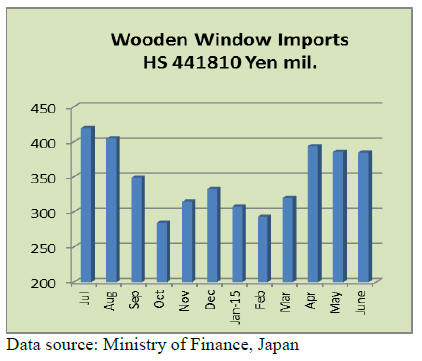
Assembled flooring
China 172126 Finland 16110 Indo 15723
June imports broke the firm upswing in imports of
assembled flooring recorded during the early part of this
year. First half 2015 imports of assembled flooring were
down 21% on the same period in 2014.
Suppliers in China hold a commanding position in Japan‟s
market for imported assembled flooring accounting for
around 68% of total imports of this product.
The other main suppliers in June were Indonesia and
Finland which each accounted for around 6% of
assembled flooring imports.
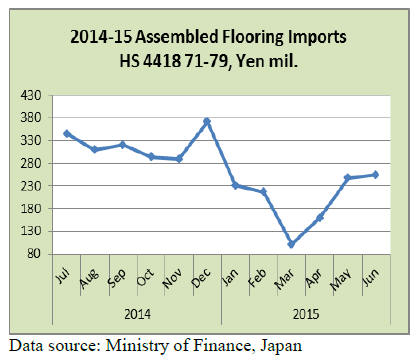
Plywood
There has been a steady decline in Japan‟s plywood
imports from the beginning of the year. First quarter 2015
plywood imports were down 26% on the first quarter of
2014 and all three major supply countries booked losses
for 2015.
First half 2015 imports of plywood by Japan from China,
Malaysia and Indonesia were down 36%, 21% and 22%
respectively. June 2015 imports from all 3 of the main
suppliers fell even more sharply than in the first half year.
Imports of plywood from China were down 33%,
Malaysia saw a 27% drop while Indonesia recorded a 31%
decline.
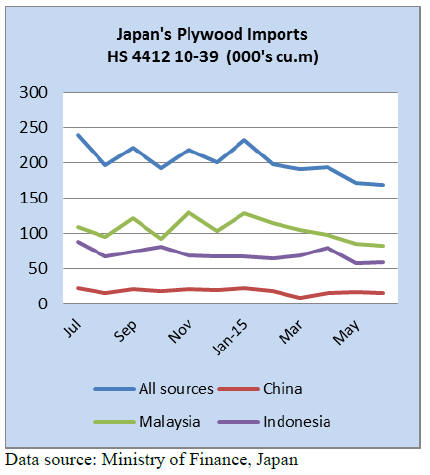 
Trade news from the Japan Lumber Reports (JLR)
For the JLR report please see:
http://www.nmokuzai.
com/modules/general/index.php?id=7
Demand projections for major wood products for the
second half
The Forest Agency made up demand projection of major
wood products for the second half of this year.
On domestic wood, demand for lumber increases while
that for plywood declines and total year figures would be
less than last year.
Imported lumber declines in the third quarter but increases
in the fourth quarter and imported logs increases. Imported
products will be less than last year. While new housing
starts are estimated to increase but total wood demand
would decline.
Domestic logs for lumber increased toward December but
less than last year. Logs for plywood decreases because
of plywood mills‟ production curtailment and rebound of
large volume of last year. Imported logs increases in the
second half of the year as they were low in the first half of
the year.
Imported lumber is low for the third quarter but the
demand increases in the fourth quarter after the inventories
decline.
Plywood declines because of market slump and mills
production curtailment programs plus decline of imported
plywood from South East Asian countries. Laminated
lumber domestic production decreases in the second half
while the imports increases for both third and fourth
quarters.
Shing Yang group reduces plywood production by half
The largest plywood manufacturer in Sarawak, Malaysia,
Shing Yang group decided to reduce the production by
half. The reasons are chronic shortage of log supply in
Sarawak and prolonging market slump of Japan market.
By this decision, plywood import from Malaysia to Japan
would be less than 100 M cbms a month.
Log production in Sarawak has been around eight million
cbms for last several years. Now further a decline is likely
in future. Shing Yang has been producing about 100 M
cbms of plywood out of which 60-80 M cbms has been
shipped forJapan.
Malaysian plywood import in June was 88,300 cbms, the
lowest in about four years. Shing Yang‟s volume has been
about 50% of total Malaysian import. After Shing Yang
decreases the production, total import from Malaysia will
further decline. There is no other sources to fill short fall
of Shing Yang.
South Sea (tropical) logs
In Sabah and Sarawak, Malaysia, dry weather continues
and rivers are drying up. This hampers barging logs from
upstream to log loading ports in some areas. Log
production continues low by this weather and tight control
by the government in Sarawak. The control is tightening
further and since July, measurement of logs and payment
of royalty are done at logging sites so this further reduces
log production.
India made log procurement more than usual in last May
then it slowed down in June but this does not ease log
market at all. On top of spiraling FOB prices, the yen is
getting weak to 122-125 yen per dollar so the arrived cost
of meranti regular is more than 13,000 yen per koku and
the users in Japan are facing final stage and lose interest to
keep buying. The log importers are desperately explaining
cornered situation to the suppliers to no avail.
Present FOB prices of Sarawak meranti regular are $285-
295 per cbm, small meranti are $260-270 and super small
are $250. They are unchanged from June. Due to
continuing high FOB prices and drop of log quality in
Sarawak, more are interested in PNG logs.
Imported plywood market
The market of imported plywood like concrete forming
panel is firming. The demand remains sluggish so despite
sharp drop of the supply, tight feeling is not serious.
Cost for the importers and wholesaler have been
increasing by higher FOB and weaker yen and the market
is catching up little by little but dealings are mainly among
dealers and the importers struggle to have enough sales.
With continuing measures to control illegal harvest in
Sarawak, Malaysia tightens log supply and the suppliers
face short log supply and higher log cost so that FOB
export prices stay up high.
With weak yen of 121-123 yen per dollar and depressed
market in Japan, it is hard to buy higher cost plywood than
present market so spot purchases continue. The importers
reduced future purchase due to large gap between the cost
and market prices so the arrivals since last May would stay
as low as 200 M cbms a month probably through August.
The importers hope that the market should react and
rebound since late August. Present prices of 3x6 concrete
forming panel are 1,500 yen per sheet delivered, which is
lower than the cost for theimporters so the importers are
asking 1,550 yen.
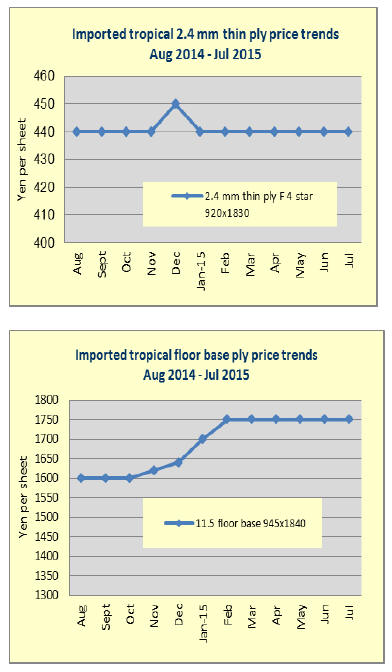 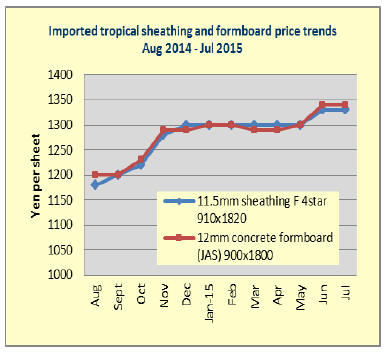
Nitori to build furniture plant in Vietnam
Nitori Holdings Co., Ltd. (Sapporo, Hokkaido) announced
to set up a subsidiary company in September to
manufacture furniture and home furnishings (cabinet, bed,
laundry and tableware related products) in Ba Ria Vung
Tau province in Southern Vietnam.
Total capital is 2.7 billion yen and Nitori will be sole
investor. This is the second manufacturing facility for
Nitori in Vietnam and total overseas subsidiaries are
twelve in total. New company‟s name is Nitori Furniture
Ba Ria-Vung Tau Co., Ltd. The president is Mr. S.
Matsukura, the president of Nitori Furniture Vietnam EPE,
Hanoi, Vietnam.
Nitori will build manufacturing plant by leasing 400,000
hectares of property in some industrial park.
Details of manufacturing products and production is not
decided yet. The plan is to start up the plant in 2017.
Manufactured products will be shipped to Japan, Taiwan
and China and will be marketed through Nitori‟s sales
network.
Log export promotion by Fukuoka prefecture
Prefecture of Fukuoka decided to promote export of local
logs as 2015 new business. Three prefectures of Kyushu,
Fukuoka, Saga and Nagasaki tie up together for log export,
which should make steady log procurement and strong
stand for overseas buyers in price negotiation.
Three prefectures have been discussing joint export
programme and Fukuoka prefecture plans to export local
logs mainly to China. It plans to export about 3,700 cbms
of cedar and cypress logs from Fukuoka prefecture from
port of Imari, Saga prefecture. Total budget is 3.1
milloion yen for 2015. The business is managed by the
conference formed by prefectural forest associations and
the prefecture will subsidize 700 yen per
cubic meter for local export logs.
Also the prefecture promotes to encourage entry of nonforest
industries such as landscape gardeners and
construction industry in an effort to stabilize forest
workers and to increase wages, which should vitalize
villages in the mountains.
To secure new comers by the forest conferences, the
prefecture subsidizes with total budget of 8.325 million
yen. Following last year, the prefecture will double the
harvest in the prefecture by promoting increasing main
harvest and also promotes building wooden structures. For
this, budget of 34.202 million yen is allocated.
|